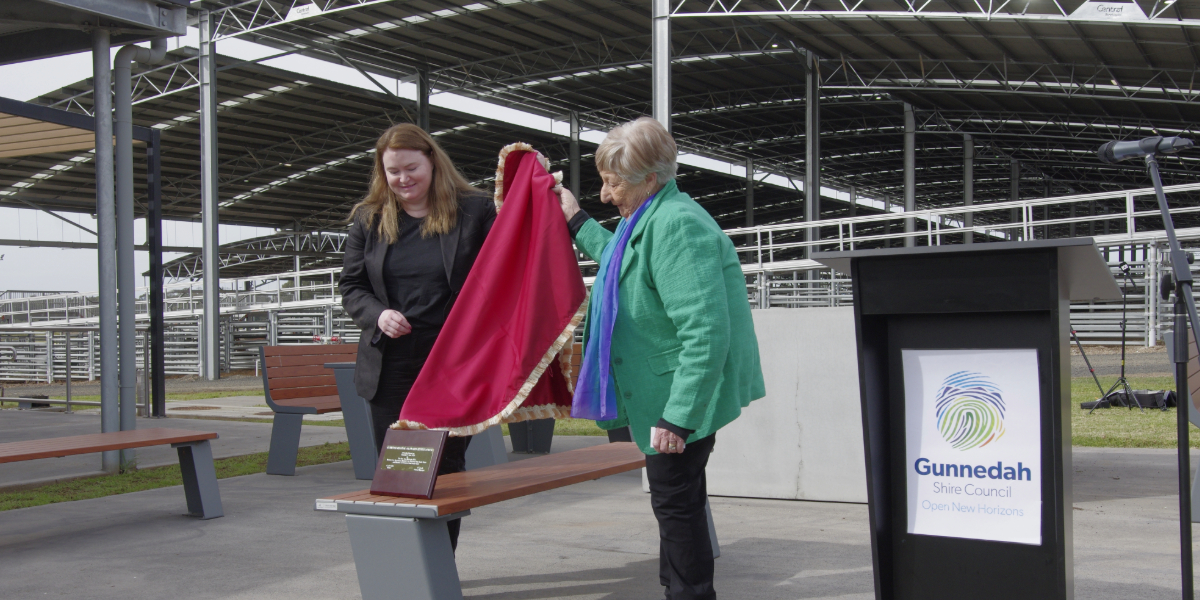The refurbished Gunnedah Saleyards were officially opened by Gunnedah Shire Mayor Colleen Fuller and NSW State Minister for Agriculture, Regional NSW, and Western NSW Tara Moriarty, yesterday, capping off the renewal of NSW’s fifth largest saleyards.
“It is a beautiful winter’s day, and we are seeing the new administration building and saleyards at their best,” Mayor Fuller said during her opening speech.
“This has been a wonderful project to watch over the past couple of years.”
“I particularly want to thank all our council staff, our council staff, our councillors, the enormous work that you put in behind the scenes, until you work in a position nobody knows, the untold house that our staff give us as a community.
“And I am eternally grateful, as I know the councillors are so and to our general manager as well. So thank you very much.”
For the first time, the yards were roofed in, putting the cattle – and the buyers – out of the weather, and a fully-kitted out cafe.
New internal roads were also built, and, crucially for biosecurity and health, a new truckwash station.
Drowned out by the mooing of 3000 head of cattle, Minister Moriarty said the project was delivered “on time and on budget” – even though the saleyards were still actively used during the renovation.
“I know how important this piece of infrastructure and upgrades to the saleyards are, and so the NSW State government is pleased to continue support,” Minister Moriarty said in her address.
“It will deliver in spades for Gunnedah and for the region, and certainly, the modernisation and upgrade of these sale yards will matter for the people who are using the sale yards, and also for this community and for the entire region.”
The renovations totalled $27.4 million dollars, with $3.7 of that from Gunnedah Shire Council and the rest from the NSW State Government. However, it is a relatively small investment compared to the $100 million Moriarty expects the facility to generate for the region, and small change compared to the $20 billion NSW ag sector.
“It matters not just to the people who are making the best produce and food and fibre in the world right here in New South Wales,” Moriarty said, “but it also matters significantly to our entire state economy.
Gunnedah Shire General Manager Eric Groth was quick to point out the value of the upgrades for Gunnedah, both the refurbishment and their ongoing use.
The refurbishment supported 118 jobs in Gunnedah during its construction, Groth said.
“[The saleyards] contribute $150 million to the local economy and about 40 jobs.”
“It also contributes in excess of $191 million to the state economy.”
“It also fulfils a critical need in allowing people from across our drawing area for sellers and buyers to gather and have conversations and connect, which can’t be forgotten,” Groth said.
Groth thanked all those involved from the State Government, the Minister, and Project Manager Phillip Lindfield.
No one was more excited for the new facilities than President of the Gunnedah Stock & Station Agents Association Tim Walsh, who started out in Gunnedah 30 years ago when the fences were wood and everyone was out in the sun.
“Four years,” Walsh said about the time it took to complete, “It was an effort, but we got there, and I think we only missed one or two sale days.”
“The upgrade has been a fantastic addition to the saleyards, especially the roof – it’s a lot better standing undercover when it rains than standing out in a Drizabone for five or six hours.”
The yards put through “about 100,000 head a year”, according to the Walsh, though he hopes the upgrades will increase that number.
The most important aspect of the upgrades, Walsh said, was that they were keeping up with industry trends, especially around biosecurity, and especially animal welfare – something more and more at the forefront of buyers’ and consumers’ minds when it comes to meat.
“They do stand out in the sun, the rain, in the paddock, but it’s good for their animal welfare (to be undercover) while they’re in the saleyards.”
Already the new facility has scored one new customer, with Somerton farmer Warwick Hooper, who’s selling some cattle in a few weeks.
“I normally take them to Tamworth,” Hooper said, “But I think I’ll put them through here.
Read all the way through to the end of the story? So did lots of other people. Advertise with New England Times to reach New England locals who are interested and engaged. Find out more here.

